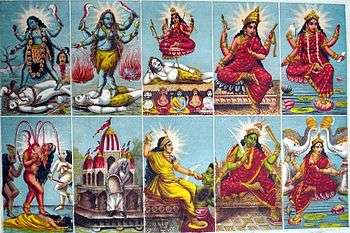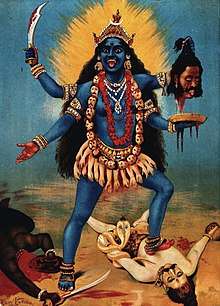Mahavidya
The Mahavidya (Sanskrit: महाविद्या, IAST: Mahāvidyā, lit. Great Wisdoms) are a group of ten aspects of Adi Parashakti in Indian Mythology. They are all forms of Parvati . After the decline of Buddhism in India, these forms of the Goddess began to be attested in the Kaula Tantrika literature.[1] The 10 Mahavidyas are Kali, Tara, Tripura Sundari (Shodoshi), Bhuvaneshvari, Tripura Bhairavi, Chhinnamasta, Dhumavati, Bagalamukhi, Matangi and Kamala.
| Part of a series on |
| Shaktism |
|---|
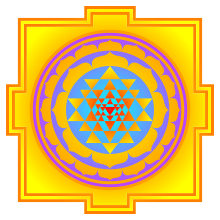 |
|
Schools |
|
Festivals and temples |
|
|
The development of the Mahavidyas represent an important turning point in the history of Shaktism as it marks the rise of the Bhakti aspect in Shaktism, which reached its zenith in 1700 CE. First sprung forth in the post-Puranic age, around 6th century C.E., it was a new theistic movement in which the supreme being was envisioned as female.[2] A fact epitomized by texts like Devi-Bhagavata Purana, especially its last nine chapters (31-40) of the seventh skandha, which are known as the Devi Gita, and soon became central texts of Shaktism.[3] In a story from the Shakta Maha-Bhagavata Purana, which narrates the creation of all the Mahavidyas, Sati, the daughter of Daksha and first wife of god Shiva, feels insulted that she and Shiva are not invited to Daksha's yagna ("fire sacrifice") and insists on going there, despite Shiva's protests. After futile attempts to convince Shiva, the enraged Sati transforms into the Mahavidyas, who surround Shiva from the ten cardinal directions.
Names
Shaktas believe, "the one Truth is sensed in ten different facets; the Divine Mother is adored and approached as ten cosmic personalities," the Dasa-Mahavidya ("ten-Mahavidyas").[4]As per another school of thought in Shaktism Mahavidyas are considered to be form of Mahakali. The Mahavidyas are considered Tantric in nature, and are usually identified as:[5]
- .Kali
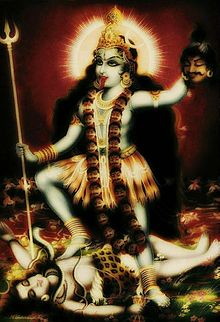
The ultimate form of Brahman, "Devourer of Time" (Supreme Deity of Kalikula systems). Mahakali is of a pitch black complexion, darkest than the dark of the Death-Night. She had three eyes, representing the past, present and future. She has shining white, fang-like teeth, a gaping mouth, and her red, bloody tongue hanging from there. She has unbound, disheveled hairs. She was wearing tiger skins as her garments, a garland of skulls and a garland of rosy red flowers around her neck, and on her belt, she was adorned with skeletal bones, skeletal hands as well as severed arms and hands as her ornamentation. She has four hands, two of them were empty and two others carried a sword and demon head.
2.Tara
_LACMA_M.81.206.8.jpg)
The Goddess as Guide and Protector, or Who Saves. Who offers the ultimate knowledge which gives salvation. She is the goddess of all sources of energy. The energy of the sun is also a grant from her. She manifested as the mother of Lord Shiva after the incident of Samudra manthan to heal him as her child. Tara is of a light blue complexion. She has disheveled hairs, wearing a crown decorated with the digit of the half-moon. She has three eyes, a snake coiled comfortably around her throat, wearing the skins of tigers, ornamented with a garland of skulls. She is also seen wearing a belt, supporting her skirt made of tiger-skin. Her four hands carried a lotus, scimitar, demon head and scissor. She had her left foot rested on the corpse of Shiva
3.Tripura Sundari (Shodashi)
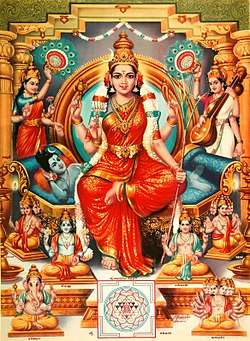
The Goddess Who is "Beautiful in the Three Worlds" (Supreme Deity of Srikula systems); the "Tantric Parvati" or the "Moksha Mukta". She is the head of manidweep. Shodashi is seen with a molten gold complexion, three placid eyes, a calm mien, wearing red and pink vestments, adorned with ornaments on her divine limbs and four hands, each holding a goad, lotus, bow and arrow. She is seated on a throne.
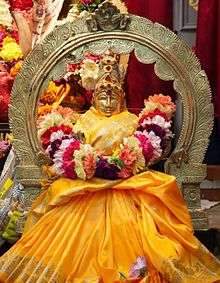
The Goddess as World Mother, or Whose Body is all 14 lokas (whole cosmos). Bhuvaneshwari is of a fair, golden complexion, with three content eyes as well as a calm mien. She wears red and yellow garments, decorated with ornaments on her limbs and has four hands. Two of her four hands hold a goad and noose while her other two hands are open. She is seated on a divine, celestial throne.
5.Bhairavi

The Fierce Goddess. The female version of Bhairav. Bhairavi is of a fiery, volcanic red complexion, with three, furious eyes, and disheveled hairs. Her hair was matted and was tied up in a bun, decorated by a crescent moon as well as two devil horns sticking out from each side. She has two protruding tusks hanging out from the ends of her bloody mouth. She wears red and blue garments and is adorned with a garland of skulls around her neck. She also wears a belt decorated with severed hands and bones attached to it. She is also decked with snakes and serpents too as her ornamentation, rarely she is seen wearing any jewelry on her limbs. She has four hands, two of which are open and two of which hold a rosary and book.
The self-decapitated Goddess.[6] She chopped her own head off in order to satisfy Jaya and Vijaya (metaphors of Rajas and Tamas - part of the trigunas). Chinnamasta is of a red complexion, embodied with a frightful appearance. She had disheveled hairs. She has four hands, two of which held a sword and another hand held her own severed head, with three blazing eyes with a frightful mien, wearing a crown, and two of her other hands held a lasso and drinking bowl. She is a partially clothed lady, adorned with ornaments on her limbs and wearing a garland of skulls on her body. She is mounted upon the back of a ferocious lion.
7.Dhumavati (The widow goddess)

Dhumavati is of a very smoky dark brown complexion, her skin is wrinkled, her mouth is dry, some of her teeth have fallen out, her long disheveled hairs are gray, her eyes are seen as bloodshot and she has a frightening mien, which is seen as a combined source of anger, misery, fear, exhaustion, restlessness, constant hunger and thirst. She wears white clothes, donned in the attire of a widow. She is sitting in a horseless chariot as her vehicle of transportation and on top of the chariot, there is an emblem of a crow as well as a banner. She has two trembling hands, her one hand bestows boons and/or knowledge and the other holds a winnowing basket.
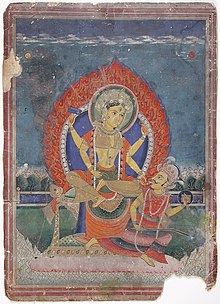
The Goddess Who Paralyzes Enemies. Goddess Bagalamukhi has a molten gold complexion with three bright eyes, lush black hair and a benign mien. She is seen wearing yellow garments and apparels. She is decked with yellow ornaments on her limbs. Her two hands held a mace and the tongue of demon Madanasur, as he's in paralysis. She is depicted seated on either a throne or on the back of a crane.
9.Matangi
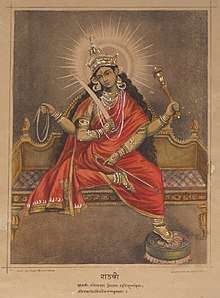
the Prime Minister of Lalita (in Srikula systems), sometimes called the "Tantric Saraswati". Matangi is depicted as emerald green in complexion, with lush, disheveled black hairs, three placid eyes and a calm look on her face. She is seen wearing red garments and apparels and bedecked with various types of ornaments all over her delicate limbs. She is seated on a royal throne and she has four hands, three of which holds a sword or scimitar, a skull and a veena as a musical instrument. Her one hand bestows boons to her devotees.
10.Kamalatmika(kamala)
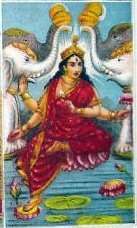
The Lotus Goddess; sometimes called the "Tantric Lakshmi". Kamala is of a molten gold complexion with lush black hair, three bright, placid eyes, and a benevolent mien on her face. She is seen wearing red and pink garments and apparels and bedecked with various types of ornaments and lotuses all over her limbs. She is seated on a fully bloomed lotus and has four hands, two of which held lotuses while two others granted her devotees' wishes and assures protection from fear.
"Do not get confused with the name of Kamala (Tantric laxmi) with laxmi,both are different goddess"
All these Mahavidyas reside in Manidweep.
The Maha bhagavata Purana and Brihaddharma Purana however, list Shodashi (Sodasi) as Tripura Sundari, which is simply a different name for name for the same goddess.[7] The Guhyati guyha-tantra associates the Mahavidyas with the ten Avatars of Vishnu, and states that the Mahavidyas are the source from which the avatars of Vishnu arose. All ten forms of the Goddess, whether gentle or terrifying, are worshiped as the universal Mother. All ten forms of the Goddess is concluded and worshiped in the Shri Chakra and Tripura Sundari is considered as the Adi Parashakti. There is another school of thought which says Mahavidyas are 12 in number additional includes Durga and Annapurna and also that they are guarded by eleven bhairava's. Name of the Goddess Bhairava's name Kali Kalabhairava, Tara Akshobhaya, Lalita Panchavaktra, Tripura Bhairavi Dakshinamurti, Bhuvaneshvari Trayambak, Chinnamasta Kabandha, Dhumavati No bhairava, Bagalamukhi Ekavaktra, Matangi Matanga, Kamala Sadashiva, Durga Dashavaktra, Annapurna Narada.
| no. | Goddesses name's | Bhairava name's |
|---|---|---|
| 1. | Kali | Kalabhairava |
| 2. | Tara (Devi) | Akshobhaya |
| 3. | Lalita Tripura Sundari | Panchavaktra |
| 4. | Tripura Bhairavi | Dakshinamurti |
| 5. | Bhuvaneshvari | Trayambak |
| 6. | Chhinnamasta | Kabandha |
| 7. | Matangi | Matanga |
| 8. | Bagalamukhi | Ekavaktra |
| 9. | Kamalatmika | Sadāṣiva |
| 10 | Dhumavati | No bhairava[9] |
| 11 | Durga | Nārada |
| 12 | Annapurna(goddess) | Daṣavakrta |
In the above list do not get confused the names of Dakshinamurti Bhairava with Dakshinamurti, Matanga Bhairava with Matanga Rishi, Sadashiva Bhairava with Sadashiva and lastly Narada Bhairava with Narada Rishi.
See also
References
- Sanderson, Alexis. "The Śaiva Literature." Archived 2016-03-04 at the Wayback Machine Journal of Indological Studies (Kyoto), Nos. 24 & 25 (2012–2013), 2014, pp. 80.
- "Mahavidya - Chinese Buddhist Encyclopedia". www.chinabuddhismencyclopedia.com. Retrieved 2020-01-03.
- Brown, Charles Mackenzie (1998). The Devī Gītā: The Song of the Goddess. SUNY Press. p. 23. ISBN 9780791439401.
- Shankarnarayanan, S (1972). The Ten Great Cosmic Powers: Dasa Mahavidyas (4 ed.). Chennai: Samata Books. pp. 4–5. ISBN 9788185208381.
- Kinsley, David R (1997). Tantric Visions of the Divine Feminine: The Ten Mahavidyas. Berkeley: University of California Press. p. 302. ISBN 9780520204997.
- Daniélou, Alain (1991). The Myths and Gods of India: The Classic Work on Hindu Polytheism from the Princeton Bollingen Series. Inner Traditions / Bear & Co. pp. 284–290. ISBN 978-0-89281-354-4.
- Kinsley, David R (1987). Hindu Goddesses: Vision of the Divine Feminine in the Hindu Religious Tradition. Motilal Banarsidass Publication. pp. 161–165. ISBN 9788120803947.
- "The Twelve Mahavidyas and their Bhairavas". www.kamakotimandali.com. Retrieved 2020-01-06.
- Goswami, Kali Prasad (2000). Devadāsī: Dancing Damsel. APH Publishing. ISBN 978-81-7648-130-4.
External links
| Wikimedia Commons has media related to Mahavidya. |
